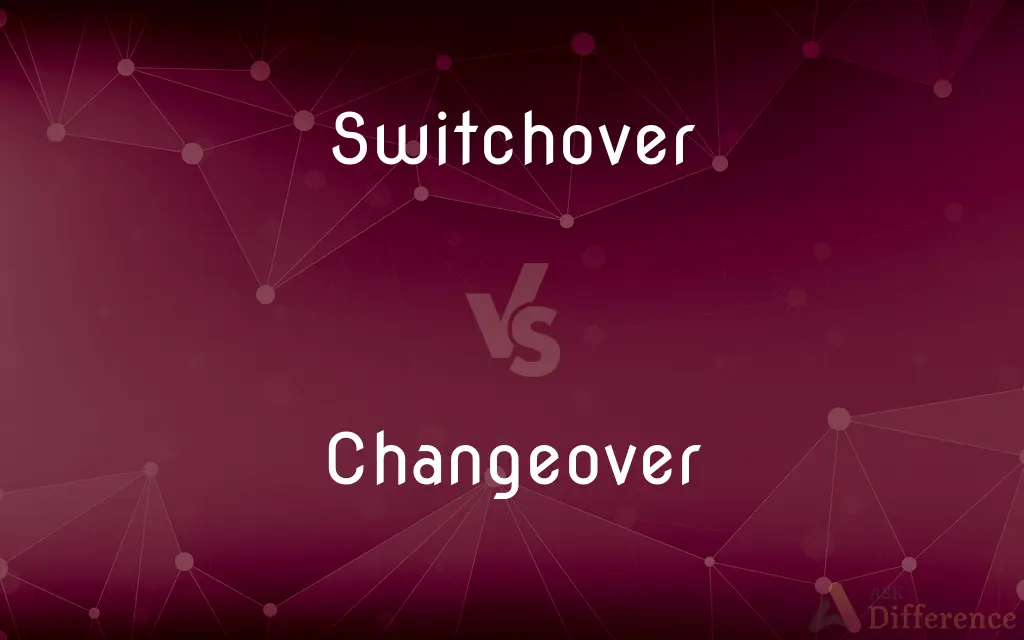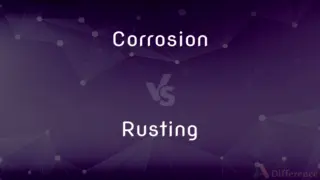Switchover vs. Changeover — What's the Difference?
By Urooj Arif & Maham Liaqat — Updated on April 4, 2024
Switchover typically refers to the process of switching from one system or source to another, often in technology or broadcasting, while changeover denotes a broader transition between states, conditions, or systems.

Difference Between Switchover and Changeover
Table of Contents
ADVERTISEMENT
Key Differences
Switchover is often used in contexts where a specific, often technical, transition occurs from one operating system, source, or set of conditions to another. For instance, the switchover from analog to digital broadcasting requires specific technical adjustments and equipment. On the other hand, changeover can refer to a wider range of transitions, not limited to technology, such as shifts in production lines, management, or even broader societal changes.
The term switchover implies a direct substitution or replacement of one element for another, often with minimal change in the overall structure or purpose. For example, a switchover in power sources from the grid to a generator during a power outage maintains the same end service: electricity supply. Conversely, a changeover might entail a more significant adjustment or transformation, affecting the structure, function, or output, like changing a manufacturing line from producing one type of product to another.
In practice, switchover is commonly associated with systems that require continuity and where the transition is expected to be seamless or with minimal interruption. Changeover, however, often involves a process that might require a pause, shutdown, or reconfiguration, reflecting a broader or more substantial transition than what is typically implied by switchover.
Another aspect of differentiation is the implication of permanence. Switchovers are often designed to be reversible or temporary, such as switching from a primary to a backup system. Changeovers, in contrast, may imply a more permanent or long-term transition, such as changing the primary material used in a product.
While both terms imply a process of transition, the nuance lies in the scale and permanence of the change. Switchover focuses on the act of switching between two alternatives, usually within a defined system or framework, whereas changeover encompasses a broader scope of transition, possibly involving significant alterations or a change in direction.
ADVERTISEMENT
Comparison Chart
Definition
Transition from one system or source to another
Broad transition between states, conditions, or systems
Context
Often technical or operational
Can be technical, operational, or organizational
Scope
Specific, with minimal changes to overall structure
Broader, may involve significant adjustments
Continuity
Designed for seamless transition
May require pause or reconfiguration
Permanence
Often temporary or reversible
More likely to be permanent or long-term
Examples
Analog to digital broadcast switchover
Changeover in manufacturing line for different products
Compare with Definitions
Switchover
The act of replacing one system with another, often to maintain operation.
The emergency switchover to backup generators was seamless during the outage.
Changeover
Transitioning between different operational states or conditions.
The factory's changeover to green manufacturing processes took several months.
Switchover
Transition between sources or modes with minimal disruption.
Switchover procedures for data centers ensure continuous service.
Changeover
May involve significant adjustments or a complete overhaul.
The changeover in company management led to a complete restructuring of the business model.
Switchover
Often involves specific, planned actions or protocols.
Broadcasting stations practiced the switchover from analog to digital signals extensively.
Changeover
Often reflects a broader scope of change than a switchover.
The hotel's changeover to a boutique concept involved redesigning all guest rooms.
Switchover
Focused on maintaining continuity of service or functionality.
The software allows for a quick switchover between user profiles without logging out.
Changeover
Can be associated with a permanent shift in direction or focus.
The changeover to renewable energy sources is a permanent commitment to sustainability.
Switchover
A temporary or reversible shift in operation or source.
The switchover to a secondary water supply happens during maintenance of the primary system.
Changeover
Encompasses a wide range of applications, from technical to organizational.
The team's changeover to remote work required new tools and work practices.
Switchover
Switchover is the manual switch from one system to a redundant or standby computer server, system, or network upon the failure or abnormal termination of the previously active server, system, or network, or to perform system maintenance, such as installing patches, and upgrading software or hardware.Automatic switchover of a redundant system on an error condition, without human intervention, is called failover. Manual switchover on error would be used if automatic failover is not available, possibly because the overall system is too complex.
Changeover
In manufacturing, changeover is the process of converting a line or machine from running one product to another. Changeover times can last from a few minutes to as much as several weeks in the case of automobile manufacturers retooling for new models.
Switchover
A complete shift, as from one system to another.
Changeover
A conversion to a different purpose or from one system to another, as in equipment or production techniques.
Switchover
A complete change or switch from one state, system or course of action to another.
After the digital switchover, analogue television broadcasts were no longer transmitted.
Changeover
A conversion or transition from one thing to another.
Changeover
An event that results in a transformation.
Changeover
An event that results in a transformation
Common Curiosities
What defines a switchover?
A switchover is defined by the transition from one system or source to another, typically to ensure continuity of operation.
What is an example of a changeover in business?
An example includes a company changing its focus from traditional retail to e-commerce, requiring changes in strategy, operations, and technology.
Is a switchover always technical?
While frequently associated with technical systems, switchovers can also apply to non-technical contexts where continuity is key.
How does a changeover differ from a switchover?
A changeover implies a broader transition, potentially involving significant changes or reconfigurations, whereas a switchover is often a direct substitution within a system.
Can a switchover be permanent?
While switchovers are often temporary or reversible, they can be made permanent depending on the context and requirements.
How does continuity play a role in switchovers and changeovers?
Continuity is a primary concern in switchovers to ensure uninterrupted service, while in changeovers, managing disruptions is a critical aspect.
What are the key considerations in planning a changeover?
Key considerations include the scope of change, impact on operations, resource allocation, and the transition plan.
Can both terms apply in emergency management?
Yes, both can apply; switchovers to emergency systems and changeovers in response strategies are common in emergency management.
Are switchovers quicker than changeovers?
Generally, switchovers are designed to be quicker and less disruptive than changeovers, which may involve more comprehensive adjustments.
Why is it important to differentiate between switchover and changeover?
Understanding the distinction helps in planning, communication, and setting expectations for the scale and impact of transitions.
Share Your Discovery

Previous Comparison
Parallel vs. Perpendicular
Next Comparison
Corrosion vs. RustingAuthor Spotlight
Written by
Urooj ArifUrooj is a skilled content writer at Ask Difference, known for her exceptional ability to simplify complex topics into engaging and informative content. With a passion for research and a flair for clear, concise writing, she consistently delivers articles that resonate with our diverse audience.
Co-written by
Maham Liaqat












































